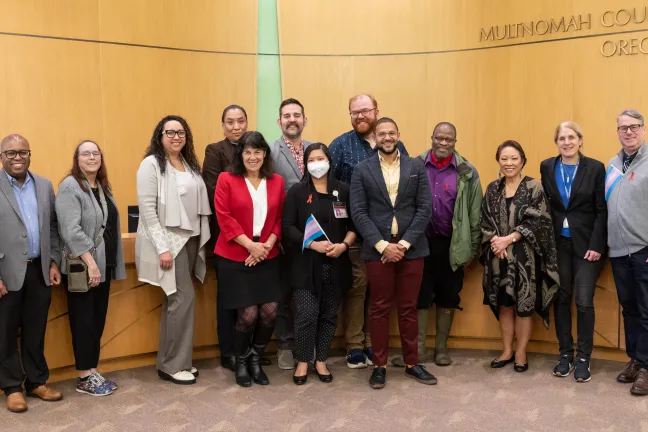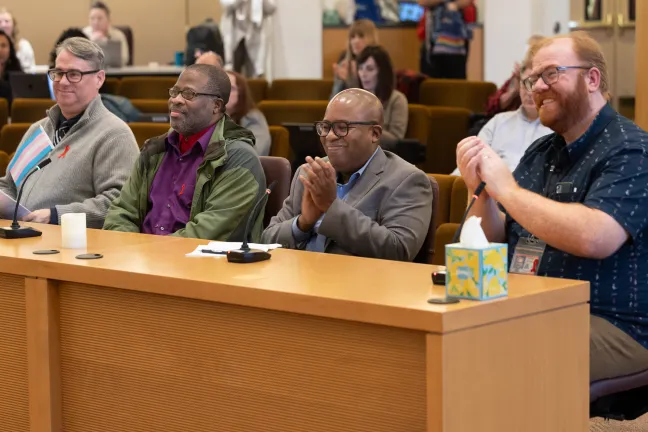The Board of County Commissioners proclaimed Dec. 1, 2024, World AIDS Day in Multnomah County during their Nov. 21 board meeting. Started in 1988, World AIDS Day is an opportunity for individuals and communities to honor the more-than-42 million people worldwide who have died from AIDS-related illness and another 39 million living with the disease. This year’s theme is “Collective Action: Sustain and Accelerate HIV Progress.”
“World AIDS Day is a day of reflection, solidarity and a renewed commitment to ending the HIV epidemic,” said Dr. Christopher Evans, an infectious disease physician at Oregon Health & Science University. “It’s really important not only to honor those we’ve lost, but also to celebrate those who are living and also to recommit to the work ahead.”
In 1994, just two weeks after testing positive for HIV, Scott Moore was diagnosed with AIDS, setting off a long and complex journey navigating the physical and mental health challenges that come with the diagnosis. Today, Moore brings both personal and professional understanding of the ongoing impact of HIV/AIDS in our community in his work as co-chair of the HIV Services Planning Council and the community affairs and policy officer at Quest Center for Integrative Health.
“I share this not to elicit sympathy, but to underscore that even with the incredible advancements in treatment, living with HIV remains a profoundly challenging experience,” said Moore.
“Yet, I also stand here as a testament to resilience. I have been in recovery for eight years. I continue to thrive. And thanks to the support of my community, access to quality healthcare and tireless work of organizations like Quest Center and the Planning Council, I continue.”
The annual commemoration marks 44 years since the first cases of HIV were reported in the United States and 30 years since then-Multnomah County Chair Beverly Stein called for a Nominating Committee to develop the first Ryan White HIV Planning Council Portland (now known as the Portland Area HIV Services Planning Council).
The Planning Council is a 30-member, community-led group of “both people living with HIV and service providers, working together to make sure that essential funding decisions that drive HIV services in the six-county area are really targeted at those services most needed and to the populations most in need of assistance,” explained Nick Tipton, who co-chairs the HIV Planning Council along with Moore and also serves as a senior regional manager for the County Health Department.
Over 40% of council members are people living with HIV.
“The diverse group is committed to ensuring that community voices are centered in regional HIV service decision-making,” said Moore.
Multnomah County and the Planning Council have partnered for collective action and progress since the group’s inception three decades ago, overseeing a network of care for low-income people living with HIV across a six-county region that spans Multnomah, Clackamas, Columbia, Washington, Yamhill and Clark counties. Multnomah County’s HIV Health Services Center in downtown Portland serves about 1,600 clients from across Oregon each year.
Nationally and in Oregon, the overall number of new HIV cases has decreased since 2018. In 2022, about 90% of Oregonians with HIV were in care, and over 3 in 4 clients were virally suppressed. Regional data show even higher rates of viral suppression for those in the Portland metro area.
“At all levels, there is progress to celebrate,” said Moore.
Health officials ascribe the decrease to a combination of condom distribution, HIV testing and treatment, and preventing infection with a medication called Pre-exposure prophylaxis, or PrEP.
“People living with HIV can now thrive with proper treatments and support, transforming what used to be a terminal illness into a manageable condition,” said Dr. Evans.
Someone with a low viral load might have no higher risk of other illnesses than the general population. And people living with HIV who take antiretroviral therapy can maintain an undetectable viral load that allows them to have healthy intimate relationships.
“We have come so far in this fight to end the epidemic,” said Tipton. “Now is not the time to step off the gas. Rather, we must redouble our efforts to both develop a vaccine and a cure while promoting the health of all people living with HIV.”
Due to systemic inequalities in access to healthcare, prevention services and social support, people of color, youth and trans women are experiencing disproportionately high rates of new HIV and AIDS infections. Moore shared that:
- The most recent national data (2018-2022) show that Black/African American people make up 12% of the U.S. population but 37% of all new HIV cases.
- Hispanic/Latino people make up 18% of the U.S. population but 33% of all new HIV cases.
- About 40% of all new cases were among people aged 25-34.
- In 2022, about 43% of new cases in Oregon were among Black, Indigenous and other people of color.
- While trans women represent 2% of existing cases in the six-county Portland service region, they represented 9% of new cases in 2023.
Multnomah County programs seek to narrow those disparities through its programs, including culturally specific case management, meal deliveries, housing navigation, medical case management and peer support.
“Collective action requires us to center the experience and wishes of Black, Indigenous, and people of color and transgender folks to ensure that our interventions are equitably ensuring all people are able to move forward into a post-epidemic future,” said Tipton.
Board comments
“I just want to thank you all for uplifting this important issue,” said Commissioner Lori Stegmann. “I appreciate the strategy to end HIV in Oregon and hope that we will continue to invest and serve our most marginalized community members. The more that we can understand, learn and know what the challenges of our community are, I hope that we can respond better.”
Commissioner Julia Brim-Edwards was living and working in Washington D.C. in the 1980s when the AIDS epidemic was unfolding. She shared that she saw firsthand the resistance to acknowledging the emerging crisis as thousands were dying.
“The impact of knowledge, scientific research, action, and a demand for action and leaning into our biggest challenges, instead of shying away from them or ignoring them, have real impacts on the lives of everyday people,” she said.
“As a medical student, resident, then attending physician, I cared for more patients with HIV than I can count,” said Commissioner Sharon Meieran. “I watched the evolution of the understanding of the disease, how healthcare workers treated people with the diseases, and the magical transformation of having this be essentially a death sentence to being a chronic condition that can be managed.”
“So many people fought and died so that I could be here today, so that people like me had access to medicine,” said Commissioner Jesse Beason, who was presiding over the Board in Chair Jessica Vega Pederson’s absence. “The science has been incredible, but it is the organizing that I find even more incredible.
“I thank you all for continuing to fight a disease that doesn’t know who people are and a disease that doesn’t blame anyone and can still get them. We have a ways to go, and I’m super excited at the opportunity that people like me, Black people across the globe, will be able to defeat this disease.”
Learn More


